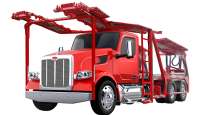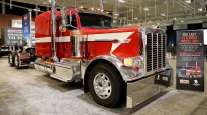Executive Editor
Peterbilt Announces New 18-Speed Transmission

[Stay on top of transportation news: Get TTNews in your inbox.]
MARSHALL, Mich. — A new, 18-speed automated transmission that will soon be available from Peterbilt Motors Co. can be spec’d for both on- and off-highway uses and with calibrations tailored to customer needs, the company announced.
The Paccar TX-18 and TX-18 Pro transmissions that will begin production in July will be offered in Peterbilt’s 567, 579 and 389 models, and will be able to handle the 1,850 pound-feet of maximum torque available from the Paccar MX-11 and MX-13 engines produced by the truck manufacturer’s parent company, Paccar Inc.
The units, which can handle up to 140,000 pounds GCWR, are the product of collaboration between Paccar and transmission manufacturer Eaton Corp. While the new Paccar units are based on the Eaton Endurant, the software and calibrations have been tuned specifically with the MX-11 and MX-13 in mind, said Kyle Crawford, vocational marketing manager with Peterbilt.

Crawford
“We’ve tested it, and we’ve validated it with that engine,” Crawford said during a Jan. 26 media event. “It’s like us standing behind it saying, ‘This is our transmission, we know that it works well with our powertrain.’ ”
Crawford and representatives from Peterbilt and Eaton hosted media at Eaton’s proving grounds for a test drive event featuring Peterbilt trucks equipped with the new transmission and Paccar MX-13 engines.
Crawford explained that while the TX-18 is intended for on-highway and mild vocational use, the TX-18 Pro is designed for off-highway, high performance and mild to severe vocational applications, such as logging, oil fields and wreckers.
Crawford said the new models will help Peterbilt “round out the portfolio” of proprietary transmissions, as the company’s current TX-12 unit maxes out at 110,000 GCWR. The TX-8 can be spec’d up to 57,000 lbs GCWR.

Host Seth Clevenger speaks with Neil Shelton of GXO and Cathy Roberson of the Reverse Logistics Association about the supply chain. Hear a snippet above, and get the full program by going to RoadSigns.TTNews.com.
The TX-18 lineup features a high-pressure diecast aluminum casing and a one-piece serviceable input shaft. A transmission cooler is optional.
The TX-18 Pro is available with an extreme duty clutch and six reverse gears, three more than the TX-18. Crawford explained that the six reverse gears can help in applications in which a truck must back up a long distance due to a lack of turnaround space at a job site. He cited a dump truck delivering dirt down a narrow service road as an example.
“Typically you are limited by the truck, only going 5 miles per hour,” he said. “Let’s say you’re comfortable doing 10 miles per hour. You’re basically saving 12 minutes going back to your pick-up point. Imagine how many more loads and how much productivity and uptime that you’re going to have to do the job that day.”
Both units come with a dual power take-off. There are three application-specific calibrations available on the TX-18 and four on the TX-18 Pro.
Both transmissions also feature what Crawford described as an “urge to move” feature that will hold the brakes when the drivers releases the brake pedal, and then slowly move the truck forward, even on an incline, to prevent it from rolling back.
“That’s huge for driver comfort,” Crawford said. “You take your foot off the brake, and it’s going to start creeping forward with 140,000 pounds.”
During the test drive, media driving on a closed course sampled the feature on hills graded at 8% and 15%. Peterbilt trucks made available for the event featured the TX-18, TX-18 Pro and TX-12 transmissions. On the test track, the new transmissions’ tightly spaced gears also were noticeable on the grades, another design feature Crawford said was developed with drivers in mind.

The "urge to move" feature that allows trucks to roll forward was demonstrated on hills graded at 8% and 15%. (Peterbilt Motors Co.)
“The last thing you want to do is be going up a big mountain, and of a sudden get to a point where there is a big gap between the next gear and they start to lose power,” he said.
The units’ next-generation controls also can sense the truck’s operating conditions and ensure the truck is in the appropriate gear, he said.
“It knows what grade you’re at, it calculates how much load you’ve got on your truck, and it’s going to select the best gear to ensure you’re maintaining your speed as much as possible, Crawford said. “It will always get you in the right gear, going up or down the hill.”
The application-specific calibrations also can help ensure customers with certain needs select the correct spec.
“We will collect data from the customer when they order — how do they plan to use this truck — and we’ll put them in the ideal calibration,” Crawford said.
Want more news? Listen to today's daily briefing below or go here for more info:




